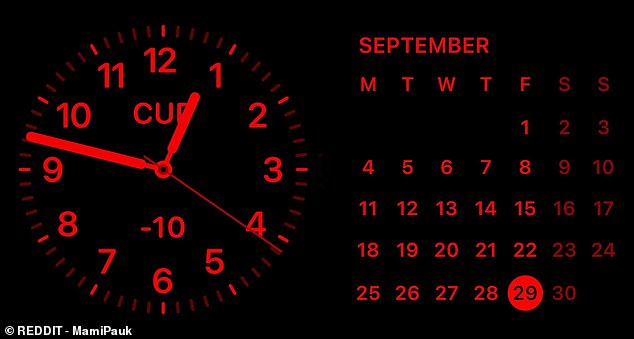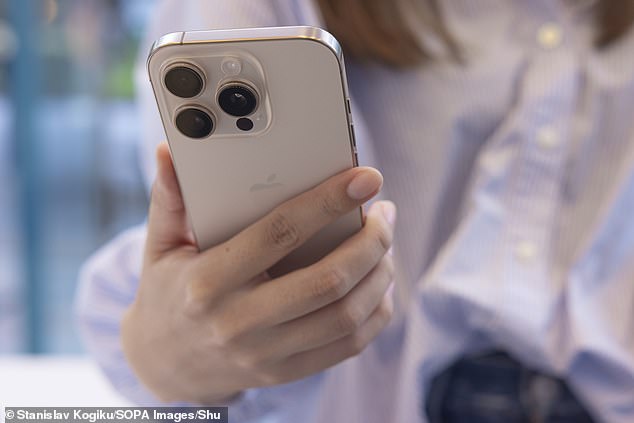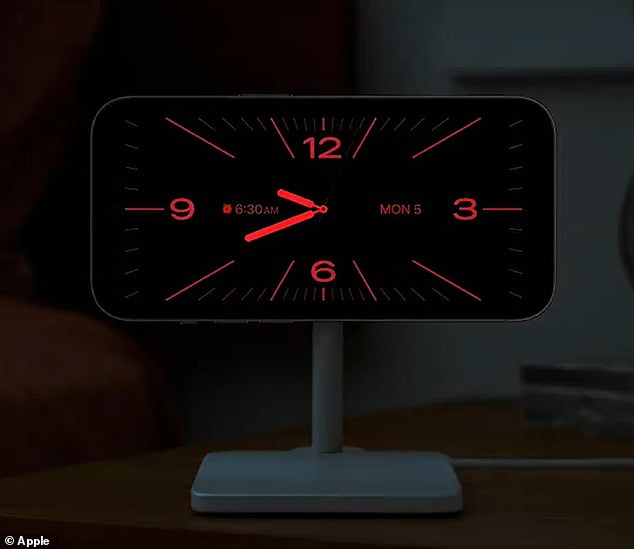iPhone fans just discovered a hidden ‘red mode’ that was introduced in last year’s iOS update.
This feature initially caused some users to worry that their devices had suffered water damage or had been hacked.
However, it is specifically designed to help users relax and sleep better at night, as research shows red lights do no effect on the circadian clock.
The so-called ‘red mode’ was introduced with Apple’s iOS 17 operating system as part of StandBy – a customizable version of the lock screen that activates when the iPhone is charging and placed on its side in landscape mode.
To activate the colored feature, you can use the Color Filters feature to apply a red tint or enable Night Mode in StandBy to adjust the screen colors to red.
To enable color filters, go to Settings > Accessibility > Display & Text Size > Color Filters.
You can also activate StandBy in Settings, connect your iPhone to a charger and lay it on its side.
“You can use StandBy to turn your iPhone into a bedside table, a photo frame, or a display for widgets or full-screen live activities,” the tech giant explains.
While some worry that the blood-red screen (pictured) is a sign of water damage, from hackers or something worse, the truth is that this surprising color change is a new feature designed to help iPhone owners and their loved ones get a good night’s sleep
‘When Night Mode is enabled for StandBy, the screen adapts to low ambient light at night and displays items with a red tint to minimize disruption while you sleep.’
Users can set the feature to ‘Automatic’, which adjusts based on the ambient light around the device, or to ‘After 20 seconds’, which activates red mode when the phone is charging on its side.
A Reddit user sought help on the platform when his iPhone’s screen unexpectedly turned red while he was lying on its side.
“Any idea why my widgets are red on the lock screen?” they asked.
Some users were quick to explain: “The red light only comes on when your room is dark.”
Others were baffled by the feature, with one user posting: ‘What!! How!? I feel like I’ve never been able to find the right setting for it.’
Another Redditor commented, “As a hardcore Android enthusiast, I have to say that I remain impressed with Apple almost every time.”
Interestingly, like this hidden Apple feature, red light can promote the release of melatonin.
Mariana Figueiro, director of the Mount Sinai Light and Health Research Center in New York City, told CNN: “The only thing you could argue is that if you turn on red light at night before bed, you minimize the disruption.” limited. of the circadian system.

And as one user on Reddit pointed out, “red mode” will help people see better in the dark as they navigate to the bathroom or kitchen for a midnight snack

iPhone fans just discovered a hidden ‘red mode’ that was introduced in last year’s iOS update. It was hidden in Apple’s iOS 17
‘(This is) because disruption of the circadian system occurs in bright or blue light.
‘In other words, it may be that there are some benefits from replacing the light you are exposed to before bed with red light, rather than adding the latter during sleep.
‘And that can lead to better sleep.’
Blue wavelength light – like the kind that glows on LED monitors and is visible in broad daylight – has been found to suppress the secretion of melatonin, a hormone that is integral to the process of letting the human body know when time to sleep.
Although some clinical studies claim the link is exaggerated, research from Harvard and the University of Toronto confirmed a link between this light exposure and shifts in both hormone production and circadian rhythms.
“The broader implication of our work is the demonstration that the lighting standard used by the lighting industry and clinical research community is inappropriate when assessing its effects on the circadian system,” said Professor Charles Czeisler of Harvard Medical School.
In other words, the color of the light is just as important as the brightness or illumination of the light when it comes to a good night’s sleep.


